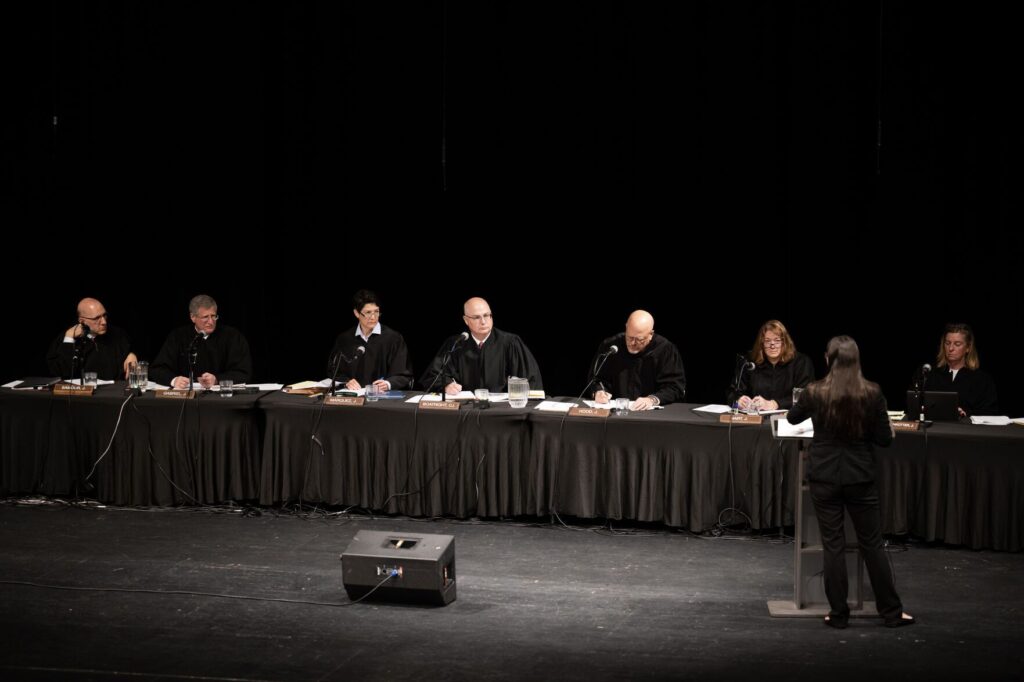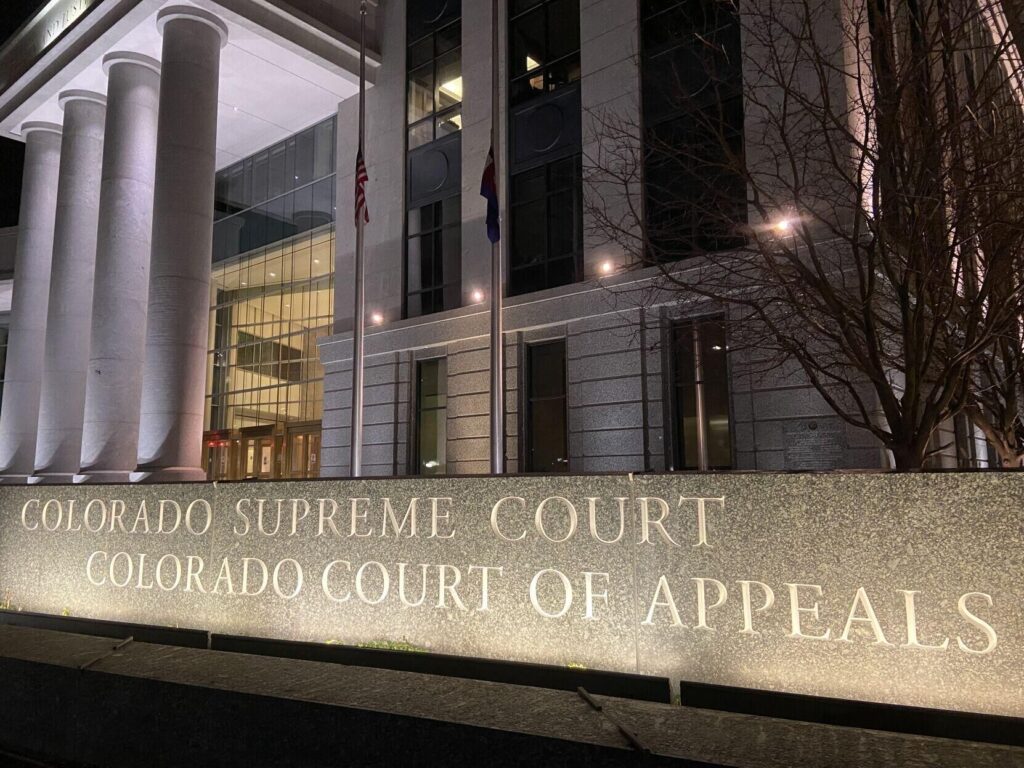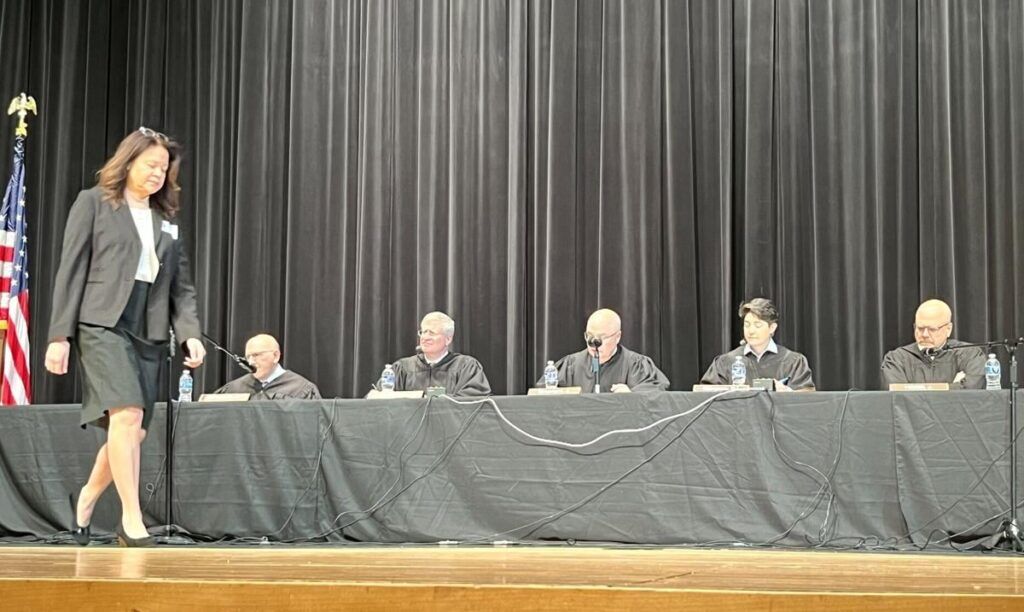Q&A with Russell Carparelli | Former judge sheds light on judicial retention

This November, voters will decide whether to retain 135 judges across the state based largely on performance evaluations from each of the 22 judicial districts and one additional, statewide performance commission.
The citizen-led performance commissions recommend whether trial and appellate judges meet or do not meet performance standards based on established criteria: knowledge of the law, communications skills and temperament, for example. The commissioners also perform courtroom observations of the judges they evaluate.
Russell Carparelli was a judge on the state’s Court of Appeals from 2003 to 2013. He also co-founded Our Courts Colorado, which gives informational presentations to the public about the judicial system – approximately 600 in total. Carparelli spoke to Colorado Politics about how the retention system operates and what voters should know before they fill out their ballots.
FAST FACTS
- Russell Carparelli is a graduate of the University of Denver’s law school and served in the U.S. Air Force on active duty from 1970 to 1990.
- He was a civil litigator in private practice from 1990 until his appointment to the Court of Appeals in 2003.
- Carparelli is a speaker and lecturer on the subjects of judicial selection, negotiation and trial advocacy.
- He is also a mediator and arbitrator at AB Conflict Resolution Services in Denver.
Colorado Politics: This year, people are going to look at their ballots and after they have voted for U.S. senator, governor and various state positions, they will see a list of judges with the question of whether each of them should be retained. When did Colorado start asking voters about retaining judges? And why do we do it?
Russell Carparelli: There was a movement in the United States to change selection of judges from elections to a system that was developed by the American Bar Association and the American Judicature Society. The concern was that the election system was not always selecting the most qualified people and that politics had too much of an interest and too much control.
So the system developed for merit selection whereby there would be a screening of applicants, and applicants would then be reviewed by a commission. Then the commission would make recommendations to the appointing authority – typically the governor. In this way, people who were not involved in politics could put their names forward, whereas otherwise their names would never be put forward. It was the combination of increasing the application pool, reviewing the merits of the applicant and still letting the elected official make the decision.
Initially there was not an evaluation system, but in time, the Colorado Judicial Institute began a movement towards having a performance evaluation system for the judges and justices, which is what we now have. Without that system, voters could vote on retention but they really did not have a lot of information about the judges.
CP: I’m assuming that when people look at the retention section of their ballot, they ask themselves, “Is this a good judge or not?” You’ve been an appellate judge who worked with other appellate judges, reviewed the work of trial judges and had your own work reviewed by the Supreme Court. Based on your experience, what does it mean to be a good judge?
RC: I would start with the motivation of the judge. The task of a judge is to preserve the Constitution and to preserve the rule of law and to make sure that every party in every case gets the benefit of our Constitution, of our statutes and is treated fairly and impartially.
Each judge has to make it apparent that he or she is doing that. It’s not only important that justice be done, but that people see it’s being done.
Second is certainly knowledge of the law and a commitment to applying the law as it is written and it has been determined by higher courts over the years. Not to allow one’s own bias to steer the case.
In the courtroom, it is important to maintain the decorum and dignity of the courtroom. You don’t want judges who, themselves, misbehave in the courtroom, who demonstrate anger. They have to maintain order and sometimes that requires they be stern with people who are misbehaving, but at the same time, the judge must maintain their own composure and dignity.
Let’s think about that: You walk into the courtroom. Let’s say it’s a rainy day. You go into the courtroom to get out of the rain and because you’re curious. You sit in the gallery to watch a proceeding. When you do that, what you’re hoping to see is a very serious and fair process. And so as you sit there, one of the things that you’ll notice immediately is the temperament of the courtroom. And you’re going to notice the temperament of the judge because the temperament of the judge is going to control most of what happens in that courtroom.
You’re gonna look at the judge and you’re going to want to respect the judge. That’s what you want in the courtroom. You want that there because you want to have confidence in the justice system.
Then there is the process that I think is invisible to most people. The judge has not only one case, but many cases he or she is responsible for. That requires very disciplined management of one’s time and attention, and at the same time does it with an efficiency that enables every case to be resolved and ruled on in a timely fashion.
CP: What you just described is a very concrete and visceral picture of what judges do, and something we can all relate to after watching crime shows on television. But what voters see in the Blue Book is a one-page summary of the judge’s performance that doesn’t give us nearly that level of detail. Is there a way we can get the more concrete picture of a judge’s performance?
RC: When a person is determining how to vote, when they’re trying to learn about the judge, they will see that there is a section for what attorneys say. And recognize that the attorneys appear in front of many judges and they represent many clients. They do have experience with judges who are better than average and less than good.
But then there is the evaluation of non-attorneys. First of all, they include litigants who can say how the judge interacted with them and how helpful the judge was to them. It also includes information from court staff, people who work with the judge on a daily basis. So pay attention to the ratings from attorneys, pay attention to the ratings from the non-attorneys.
The one-page summary will generally give you just percentages of attorneys who thought the judge should be retained or not retained, non-attorneys who think the judge should be retained or not retained. Understand that half the people in lawsuits lose, so half the people will be unhappy. And yet when you see the percentage of 70, 80, 90 percent recommending retention, that is a significant vote of confidence.
We have another tool: Evaluations are done midterm in a judge’s tenure. When that is done, the commissioners make recommendations that sometimes tell the judge or justice what they need to improve. And then on the year of retention, the evaluation addresses that same topic – whether the judge has made the improvement or not. So it is very useful to determine whether the judge has accepted feedback and responded to feedback.
It’s very difficult to conclude that one’s information or insight is superior to that of the commissions.
CP: And yet, the recommendation to voters isn’t just a product of numerical inputs and outputs. These are humans, with biases and opinions, who are making the decision – based on data from other humans with biases and opinions. So I’m wondering, when you were an appellate judge, did you ever see someone be retained who you believed should not have been? Or someone who lost their job who maybe shouldn’t have?
RC: It’s true that the commissioners come from a variety of backgrounds. The people who submit evaluations and surveys come from a variety of backgrounds. Our biases always color our comments and that affects our decisions.
When you see a consistency of 70, 80, or 90 percent, I think that provides you an objective accumulation, an objective summary.
That said, I don’t recall any situation in which I thought a judge or justice would not be retained when it wasn’t appropriate. I don’t recall a situation where a judge was retained who should not have been retained. That’s not to say I think every judge who is retained is quality. That’s not to say some judges don’t really need improvement who have been retained.
So generally speaking, I have great confidence in the system and great confidence in the voters.
There are so many voters who don’t look at any information and have a very strong bias in their voting. When I became a judge, I had a friend tell me, “Thank goodness I can now vote to retain a judge. Because I always vote not to retain all judges.” The fact is, there are so many voters who just have a basic rule that they vote to retain all judges or they vote not to retain all judges. They do that based on very personal values of trust in the system or whether they distrust people.
CP: The performance evaluations don’t include certain pieces of information. They don’t talk about the cases a judge has handled, the times they’ve been upheld or reversed on appeal, or about any professional discipline they’ve encountered. How concerning is it that those aspects of a judge’s performance are omitted?
RC: The disciplinary system is separate, and it also has commissioners. Anybody can make a complaint about a judge. If we were to list all of the complaints, we would not know how many of them are valid or invalid. And so a mere listing of whether complaints have been filed really doesn’t tell us anything we can rely on.
So we have to rely on the disciplinary commission to do their job and to determine whether a judge has conducted himself or herself in a way that’s contrary to the ethical requirements. If there is a credible finding of a disciplinary problem, it is made public.
Reversals on appeal are difficult to evaluate. First of all, trial judges are in the courtroom under great time pressure. They have somewhat limited information based on what the lawyers have given them thus far. Early in the case, the judge may make a ruling that later in the case maybe doesn’t work.
But their time is limited and they act alone and they act – not spontaneously, exactly, but on very short time frames. I would say that whether a judge has been reversed is not really a good indicator. Whether they have been reversed consistently, repeatedly on a particular issue, that would be more significant.
And one other thing: Each case has its own considerations of what’s a problem or not. Once again, being reversed in one particular case on one particular set of facts does not necessarily reflect a judge not understanding the law. That’s not to say that the frequency of reversals is of no value to the voter. It is something that is appropriate to look at. But recognize that it is a very rough measure. It has a lot to do with the circumstances of each case.
I think it is one of the weaker indicators for a trial court judge. For appeals court judges, it’s a similar matter. The commission actually reads the opinions and considers the quality and they consider how the opinion on reversal dealt with the lower court or the appeals court.
CP: This year, all of the judges who stood for retention have been deemed to meet performance standards. People might look at that and go, “It’s just not possible that every single judge is doing a great job. So something must be flawed about this process.” What do you think about that critique?
RC: I think it ignores one very important variable. Our system of selection screens the judges. People who are not particularly suited to the bench are not likely to apply because this process involves so much evaluation.
Let me say it a little differently: If someone is just looking for recognition and wants to have a title and an important job, they’re gonna be discouraged from applying because the process is such a different process. The job is hard. They’re evaluated. They have to stand for retention.
The fact that our judges perform so well has a lot to do with our selection process. If one were an entrepreneur and one wanted to hire good employees who stay around, they would be delighted to make a selection process that found the best people.
That doesn’t mean they’re all great judges. There is a spectrum and some judges are extraordinary and outstanding. There are others who are quite average. And then there are others who aren’t quite as good as you hope they may be. That is the question.
CP: So it seems the retention process can affect judges in a couple of ways. It can take decent judges and guide them into becoming better judges. And it can force underperforming judges to take a look and decide whether they want to continue doing this job – and that’s assuming the performance commissions are getting a full and accurate picture of what’s going on with each judge. How else does retention affect the quality of the judicial branch?
RC: You make a good point that people should be aware of. During the evaluation process, a judge is not required to make the decision of whether to stand for retention or not until he or she has gone through the evaluation, has met with the commission and knows what the commission is going to recommend.
So someone for whom the commission will say “does not meet performance standards” may well be discouraged – and, in fact, we know this – many are discouraged from standing for retention. It is at least embarrassing to stand for retention and have the system say you’re not meeting standards. It is also a risk that you will be non-retained.
Some judges will decide not to stand for retention, or will decide to resign or retire because they got a bad evaluation.
As you perform your duties, there is an awareness that you’re constantly being evaluated. The evaluations are sent out on a regular basis during your tenure. There’s constant feedback. There may be one trial that did not go well and there was friction in the courtroom and one or more of the parties might not have kind things to say about you. That awareness helps the judge the next time understand what went wrong and not have it happen again.
The whole process is a constant evaluation.














